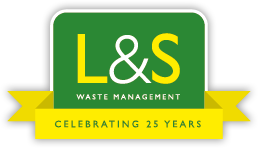Your team’s comfort starts here.

If you are unfamiliar with the process and procedures around skips and skip hire, then it’s easy to underestimate just how much waste a refit, demolition or clear out can generate. If you are planning on hiring a skip then it’s important for you to ensure that you choose the right skip size and type for your project. We quite often see customers get this wrong and subsequently overloading their skip.
Here we help you understand the rules and risks behind overloading a skip, and what steps you can take to avoid this during your skip hire period.
How much is too much?
This might seem like a fairly obvious question, and we do quite often see flagrant interpretations of what people deem acceptable. However, as a general rule waste should not exceed the height of the skip walls. It is also not acceptable, although an all to common sight, to see old doors, planks, mattresses, rubble, etc used to try and raise the skip wall!
We appreciate that its not easy, especially if your inexperienced with skip hire, to get this right, but try to keep a close eye on the raising level of waste in your skip. If you do overfill it, remove waste from the top so that your waste stays below the top of the skip walls.
How to avoid overloading a skip
With just a bit of planning and attention, it’s actually quite easy to avoid overfilling your skip. First of all, make sure you’re hiring the right size of skip for your project.
Take an inventory or estimate of the waste you’ll need to dispose of in a skip and discuss this with L&S Waste at the point of ordering. If you are booking online we offer a guide to our skip sizes and the equivalent in the number bins that each skip equates to. This will give you the most accurate idea as to the most appropriate skip size for your job, meaning you’re not underestimating the scale of the project and choosing a skip that’s far too small.
Why it’s important not to overload a skip
It’s easy to be tempted to overfill a skip if you’re close to the end of the project and realise that your skip is too small, and you might think you’re saving a few quid by cramming everything in. However, overloading a skip is unsafe and irresponsible and can pose a risk to you and the wider public, especially if your skip is placed on a public highway.
An overloaded skip is likely to be too heavy to transport safely and many operators, including L&S will refuse to collect an overloaded skip due to safety reasons. Skip hire companies will have to lift your skip onto the back onto their truck, and to this requires a steady balance. A skip that’s too heavy could make this dangerous – or even impossible. Heavy skips can also damage the vehicle, the lifting mechanisms or the operatives themselves during transportation.
Moreover, an overloaded skip poses a significant risk to the general public. We have seen many instances where skip waste has been strewn all over the public highway as a result of over stacking. Unsecured waste extending outwards from the skip could fall or shift, harming other drivers or pedestrians.
In short, it’s simply not worth the risk as not only will you be personally liable for any damage caused as a result, but your skip operator will likely refuse to take away and overloaded skip and you could be charged for the inconvenience.
If you are unsure which skip is the most appropriate for your project,
give one of our friendly knowledgeable team a call and we’ll be able to help.
Company Bio
Find out why L&S is no ordinary waste management company.
Go >
L&S In The Community
Learn more about our community projects.
Go >
Meet The Team
An introduction to the L&S management.
Go >












